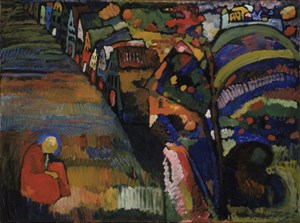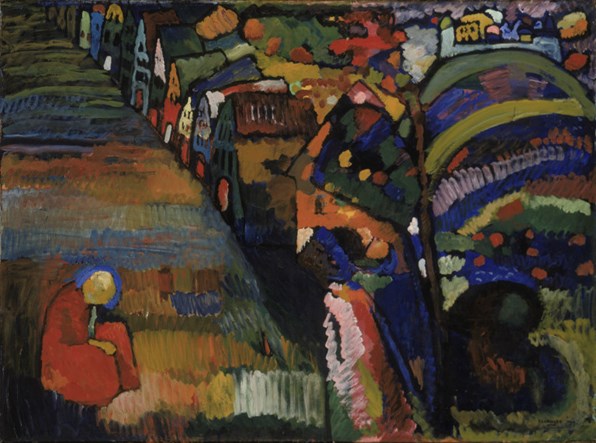
The Restitutions Committee has just issued a binding opinion about the application for restitution of the work Bild mit Häusern (1909) by Wassily Kandinsky. This oil painting is in the collection of the Stedelijk Museum Amsterdam. The Stedelijk bought the painting on 9 October 1940 at the auction of Frederik Muller & Co. in Amsterdam. Heirs of previous owners of the work sought restitution of the painting.
Image: Wassily Kandinsky, Bild mit Häusern, 1909. Collection Stedelijk Museum Amsterdam c/o Pictoright, Amsterdam 2004.
The Restitutions Committee has just issued a binding opinion about the application for restitution of the work Bild mit Häusern (1909) by Wassily Kandinsky. This oil painting is in the collection of the Stedelijk Museum Amsterdam. The Stedelijk bought the painting on 9 October 1940 at the auction of Frederik Muller & Co. in Amsterdam. Heirs of previous owners of the work sought restitution of the painting. In late 2013 the City of Amsterdam, the Stedelijk Museum Amsterdam and the heirs, represented by their lawyer, requested the Restitutions Committee to issue a binding opinion on this work.
After considering the case, the Restitutions Committee today issued a binding opinion. The Committee has concluded that the municipality of Amsterdam is not obliged to restitute this painting to the Applicants.
Over the past two decades, the Stedelijk Museum Amsterdam has actively participated in a national research project into the provenance of items of cultural value whose owners may have lost possession of the work involuntarily as a result of circumstances directly related to the Nazi regime. Anyone who believes that they have a rightful claim to a work of art is invited to submit a case, jointly with the museum and the City of Amsterdam, to the Restitutions Committee, an independent advisory Committee set up by the Dutch government. This Committee reviews the research undertaken by the museum and information submitted by the Applicant, after which the Committee conducts its own investigation, based on which it offers a binding opinion.
 Wassily Kandinsky, Bild mit Häusern, 1909. Collection Stedelijk Museum Amsterdam c/o Pictoright, Amsterdam 2004.
Wassily Kandinsky, Bild mit Häusern, 1909. Collection Stedelijk Museum Amsterdam c/o Pictoright, Amsterdam 2004.
After conducting its own extensive research, the Restitutions Committee concludes that the most probable scenario is that the painting was sold at auction in 1940 with the cooperation of Irma Klein and Robert Lewenstein, after the latter inherited it from his mother Hedwig Lewenstein-Weijerman, who died in 1937. The Committee concludes that the sale of the work cannot be seen in isolation from the Nazi regime, but was partly related to the deteriorating financial circumstances in which Irma Klein and Robert Lewenstein found themselves prior to the German invasion. In the Committee's view, this offers a less strong basis for restitution than a case involving the theft or seizure of a work. Moreover, in the period after the German occupation, there are no indications that Irma Klein approached the museum (the municipality) to request the return of the claimed work, while it can reasonably be assumed that she knew or could have known that the work was there. The Restitutions Committee also established that there is nothing to suggest that the museum did not acquire the work in good faith in 1940. The Restitutions Committee therefore concludes that the municipality and the museum are not obliged to restitute the work to the heirs.
Jan Willem Sieburgh, interim director of the Stedelijk Museum: “We consider it important that the history of this work has now been studied as thoroughly as possible and that, after years of research following our own, the Restitutions Committee has finally been able to arrive at a binding opinion. According to this advice, the work may remain in the collection of the Stedelijk. We realize that this is disappointing for the Applicants, and that this painting will forever be associated with a painful history. The relationship between our collection and the Second World War remains an important topic, and one we will continue to share information about with the public, online and in gallery presentations.”
Over the last twenty years, Dutch museums participated in the national research project led by the Netherlands Museum Association (NMV) into the provenance of works of art produced before 1945, which were acquired by collections since 1933 under suspicious circumstances. These cultural artefacts may have been looted, sold under duress, confiscated, or acquisitions of dubious provenance that took place before or during the Second World War. Since 2013, the outcomes of the museums’ investigations have been published on the website www.musealeverwervingen.nl. The Stedelijk, and the Municipality of Amsterdam which owns the collection, value transparency concerning the art in its collection and, in 2015, produced the exhibition and publication The Stedelijk Museum and the Second World War which explored this topic (€ 29,95, ISBN 978-90-593-7404-1).
Of the almost 4,000 works in the Stedelijk collection that fell within the remit of the research project, 15 works were identified as having a potentially questionable provenance, or may have been wrongfully obtained from their rightful owners in the period 1933 to 1945. This relatively high number is also due to exceptional circumstances: the Stedelijk was the first museum in the Netherlands to have a bunker in the dunes near Castricum to safeguard its collection during the war. Other museums such as the Rijksmuseum, Frans Halsmuseum, Boijmans and the Lakenhal, also stored work there for safekeeping, as did private collectors. In total, the bunker temporarily housed over 500 collections. The inventory lists, which were often handwritten, are incomplete; to protect artworks belonging to Jewish collectors from confiscation, former curator Willem Sandberg removed indications of ownership and destroyed or hid the accompanying documentation. As such, it’s possible that the museum may have no clear records of how and when certain art works were acquired because they were owned by Jewish collectors who entrusted the works for safekeeping, and failed to return after the war.
The Stedelijk does everything in its power to find and contact possible relatives or heirs in connection with the 15 works of art, and discuss the history and future of these works with them. Anyone who believes that they have a rightful claim to an object is invited to submit a case, jointly with the museum, to the Restitutions Committee. By placing the matter with the Restitutions Committee, both the museum and the Municipality of Amsterdam (owner of the collection) acknowledge that the decision of the Committee is binding.

ArtDependence Magazine is an international magazine covering all spheres of contemporary art, as well as modern and classical art.
ArtDependence features the latest art news, highlighting interviews with today’s most influential artists, galleries, curators, collectors, fair directors and individuals at the axis of the arts.
The magazine also covers series of articles and reviews on critical art events, new publications and other foremost happenings in the art world.
If you would like to submit events or editorial content to ArtDependence Magazine, please feel free to reach the magazine via the contact page.